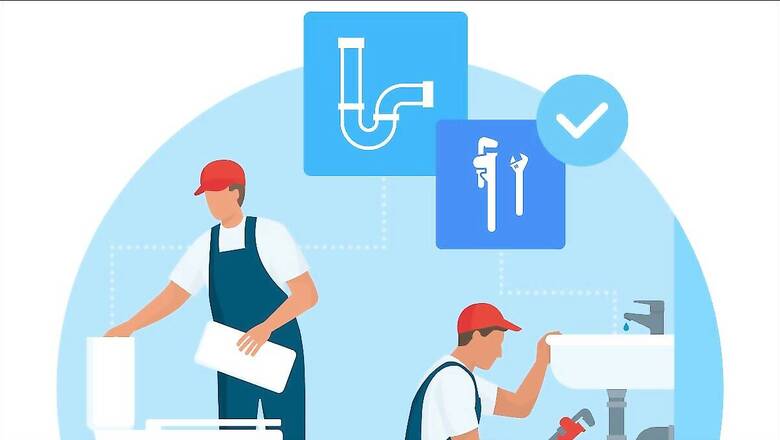
views
Climate change is real. A fact that is brought home to us in India, every monsoon. Each year, the monsoon season brings heavy rains, lashing winds, floods, landslides and waterlogging to many parts of India. In addition to losses borne in the form of damaged crops and property, the affected populations have to bear the indignity of having no privacy to take care of one very basic need: going to the toilet.
Waterlogging and drainage issues in toilets don’t wait for floods and landslides. Often, a strong deluge is enough – we’ve all seen what happens to these toilets: backed up drainage, waterlogged and overflowing toilets, pests and flies and mosquitoes everywhere. These can have severe consequences for public health through the spread of diseases like diarrhoea, typhoid, cholera, and hepatitis directly through pollution of land and water bodies with waste water, and indirectly through vector borne diseases like malaria and dengue, which spread because toilets make such excellent breeding grounds for mosquitoes.
This happens because our toilets are not designed to cope with the excess water and become flooded, clogged or damaged. In addition to causing disease, this also results in other problems like the danger of physical or sexual violence for women, young girls, and gender non-conforming people who can be targeted when they go searching for a secluded place to go to the toilet, because their usual toilet is unusable.
Since our monsoons are here to stay, and climate change models are predicting a further rise in global temperatures (which we know results in stronger and more erratic monsoons), we need to find more innovative solutions.
Innovative Solutions and Technologies
Worldwide, people are grappling with the same problems we are – how can we build more safety in a world where the mighty weather is posing increasingly greater challenges? Here’s a list of a few innovative solutions that won us over.
Nature-based solutions
Nature-based solutions are solutions that use natural processes or elements to address environmental challenges. They can help improve water quality, reduce flood risk, enhance biodiversity, and provide social and economic benefits. Some examples of nature-based solutions for monsoon-ready toilets are:
- Constructed wetlands: These are artificial wetlands that use plants, soil, and microorganisms to treat wastewater from toilets. They can remove pollutants, pathogens, nutrients, and organic matter from the wastewater, making it suitable for reuse or discharge. Constructed wetlands can also provide habitat for wildlife, aesthetic value, and recreational opportunities.
- Rain gardens: These are shallow depressions planted with native vegetation that capture and filter stormwater runoff from roofs, pavements, or other surfaces. They can reduce the amount of runoff that enters the sewer system or water bodies, preventing flooding and pollution. Rain gardens can also enhance the beauty and biodiversity of urban landscapes.
Decentralised systems
One way to prevent waterlogging and drainage problems is to reduce the dependence on centralised sewerage networks, which can be easily overwhelmed or damaged by floods. Decentralised systems are systems that treat and manage wastewater from toilets at or near the source, rather than transporting it to a centralised facility. Some examples of decentralised systems for toilets are:
- Composting toilets: convert human excreta into compost, a nutrient-rich soil amendment that can be used for gardening or agriculture. Composting toilets do not require water or sewer connections, and can reduce water consumption, waste generation, and greenhouse gas emissions.
- Biogas toilets: use anaerobic digestion to convert human excreta into biogas, a renewable energy source that can be used for cooking, lighting, or heating and also produce a liquid fertiliser that can be used for irrigation or crop production.
- Urine-diverting dry toilets: separate urine from faeces at the source, and store them in separate containers for further processing or reuse. By preventing the mixing of urine and faeces, they reduce odour, pathogens, and nutrient loss. They can also enable the recovery of valuable resources from urine and faeces, such as nitrogen, phosphorus, potassium, and organic matter.
Smart technologies for monitoring and managing water levels
To enhance the performance of toilets during monsoon season one can use smart technologies for monitoring and managing water levels in toilets and sewerage systems.
Some examples of these technologies are:
- Sensors: can measure various parameters related to water, such as depth, pressure, flow, quality, and temperature and can be installed in the toilet tank, pipes, drains, septic tanks, or nearby water bodies to detect changes in water levels and alert the toilet users or managers.
- Pumps: can use mechanical or electrical power to drain excess water from the toilet or to supply water to the toilet when needed. They can be controlled manually or automatically based on the sensor data.
- Valves: regulate the flow of water through pipes or channels and can be used to prevent backflow of water from drains or sewers into the toilet or to divert water from different sources or destinations. They too, can be controlled manually or automatically based on sensor data.
Bringing innovative solutions to bear in India
What we talk about matters. When we talk about something, we give it our collective attention – we learn from one another, uncover our blind spots, and find solutions. We understand nuances, we recognise stakeholders. It takes the work of all our hands to create lasting change.
Fortunately, in India, leading brands like Harpic and News18 have come together to amplify the importance of safe and clean toilets to our society as a whole. Harpic and News18’s Mission Swachhta aur Paani initiative brings together all the right stakeholders in one platform, creating the right conditions for important conversations and actions to take place.
Mission Swachhta aur Paani is a movement that advocates for inclusive sanitation, ensuring access to clean toilets for everyone. It promotes equality regardless of gender, abilities, castes, or classes, emphasising that clean toilets are a shared responsibility.
Clean and safe toilets for all means that our communities are healthier, our children spend more days in school and less days out sick, girls don’t drop out of school, our workplaces are more diverse places, and that our cities and towns are cleaner, safer, and more welcoming. Our voices matter. If each of us writes to our local municipality or to our elected officials, who can ignore us?
Together, we have the power to create a Swasth Bharat, through a Swachh Bharat. Join us here, to learn how you can play a part in this national transformation.















Comments
0 comment